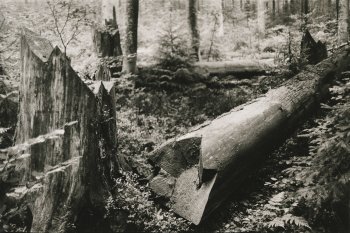The exhibit “On the Border – Grenznah”, in its own way, is a retrospective of the works of a group of Czech, German, Austrian, French and Japanese artists, related to a quite specific place in the landscape. Its topos is the historic place known as Tummelplaz in the middle of the Šumava range and Bavarian forests, full of springs, rocky outcrops, impenetrable thickets and forest detritus. Since the 1970s, the forest was declared a strictly protected zone, and is quickly transforming into a primordial-like forest. Is it really a primeval forest, or does it merely remind us that such a thing once existed? That is the question which each of the participating artists had to deal with. Without regard, of course, to the finding of specific forms of artistic expression, from simple relaxing and being in the landscape, up to every possible nuance of personal expression and all imaginable ways of sharing - touch, recording, transformations of the seen, heard and felt.
Miloš Šejn
Participants: Tomáš Černý, Michala Dašková, Kateřina Dobroslava Drahošová, Christina Frank, Lenz Geerk, Petr Gruber, Eva Jaroňová, Helena Jiráková, Bastian Kalous, Pavlína Komoňová, Petr Košárek, Olga Alia Krulišová, Karel Kunc, Radek Květoň, Dominik Lang, Matěj Lipavský, Aleš Loziak, Tammo Lünemann, Gabriela Marková, Pavel Matoušek, Helena Neubert, Eva Nováková, Eva Pejchalová, Simon Pfeffel, Anna Pleštilová, Alena Plíhalová, Markéta Prášková, Rudolf Samohejl, Julia Schmölzer, Aneta Šebelková, Nikola Šéfrová, Miloš Šejn, Adéla Součková, Pavel Storch, Lenka Štukhejlová, Kateřina Sudolská, Adéla Taubelová, Johanna Tauber, Radka Tippmanová, Akiko Ueda, Markéta Vacková, Ján Valík, Baptiste Vandaele, Robert Vanis, Eliška Vaňková, Marie Vránová, Stefanie Weigl, Benjamin Zanon, Barbora Zava, Jan Zdvořák.
Accompanying program: On the border - interpretation of wilderness from perspectives of science and art - April 16, 6pm
Financial support: NP Bayerischer Wald, the Czech-German Future Fund.
.
.
.
On the Border – Grenznah is a creative symposium for students on the subject of wilderness. The name is taken from the Czech-German Bayerischer Wald area, where it has been taking place for six years. This exhibition of the same name is curated by Tomáš Černý and Pavel Storch, together with their long-time collaborator Miloš Šejn, who will present a comprehensive retrospective of the previous years’ activities. At the same time, however, the curators will create a space for the audience to contemplate the development of this project in the coming years, as well as a number of related issues associated with the relationship between humans and the environment.
The idea to organize the symposium On the Border – Grenznah is closely connected to a place called Tummelplatz in the Bavarian forest. This area, which is not managed by humans, has been left to fend for itself, and serves as a natural laboratory. Visitors to this wilderness are, consciously or not, confronted with the question, are we part of the wild, or are we merely visitors? Should we protect nature from the influences of civilization, or is this a kind of human arrogance, that we can decide what is right for other species? What would a sustainable model for wilderness actually look like? Who are we protecting it for? For our own needs, or for its independent existence, separate from our own? In Central Europe, what does the word “wilderness” even mean? Is it merely a naive and romantic illusion? How can we capture the experience of moving through the open landscape?
The site of these symposia is the cornerstone of this exhibition, not the mere presentation of works that were created there. At the same time, it can be seen as a test of the resilience of this topic. It raises the question of whether work closely connected with the direct experience of the wild can be taken and exhibited in a diametrically differing gallery environment. Will the exhibited artefacts become decoration from the distraction of their new context, or will they serve as confident witnesses to the extraordinary experiences of their creation?
Jana Chlubná




















